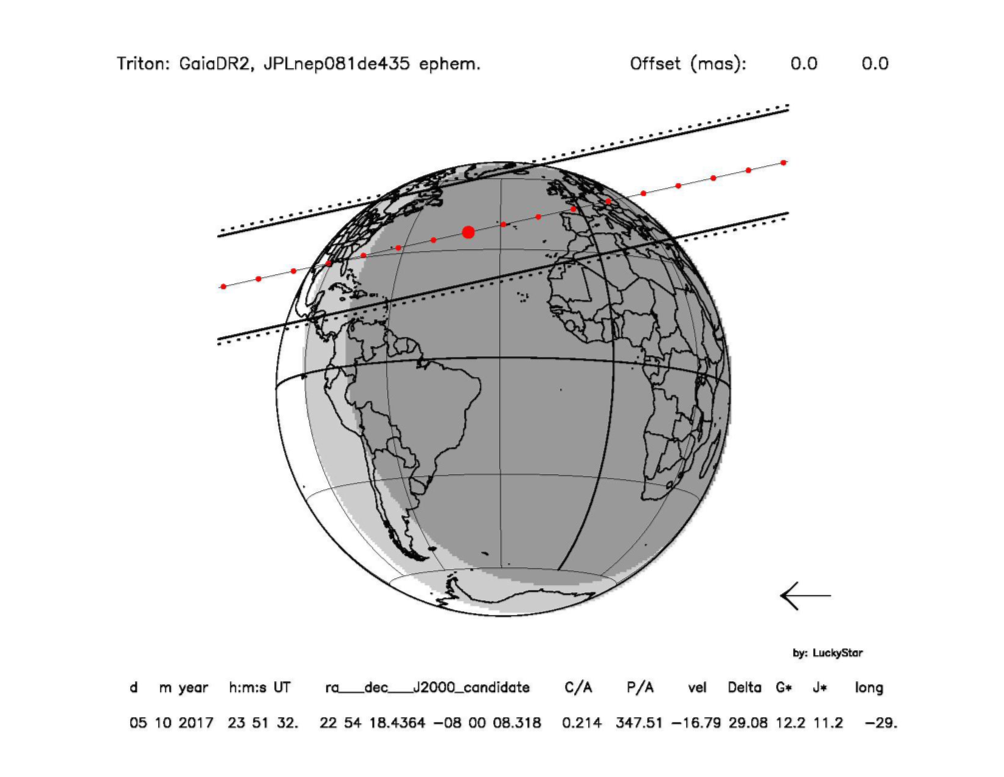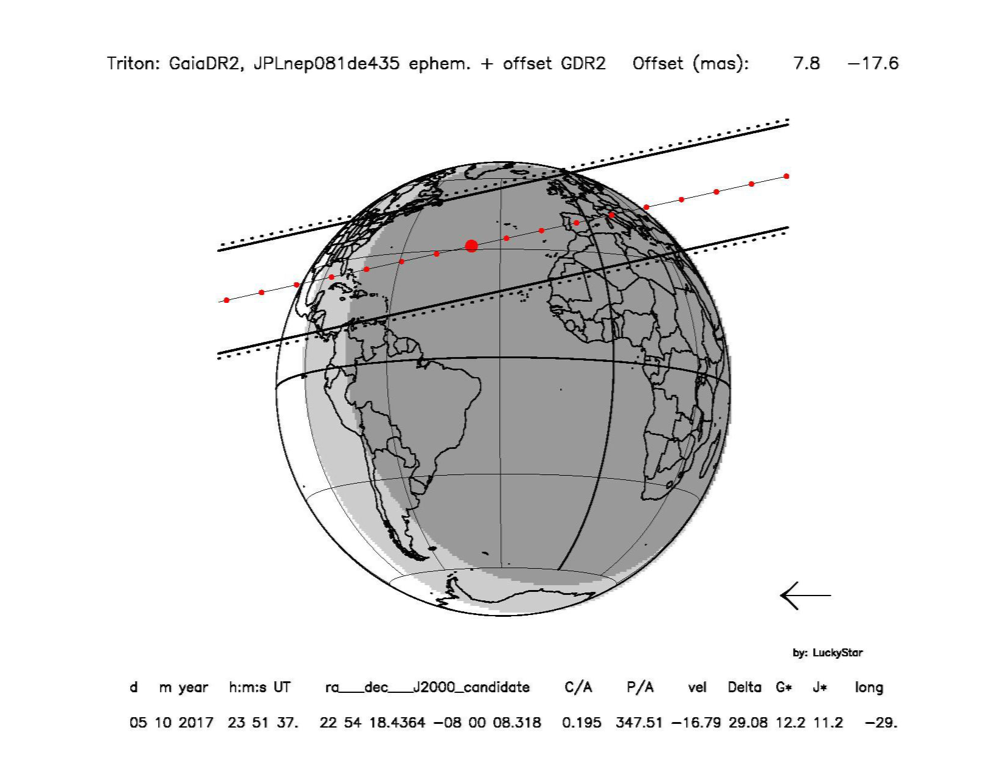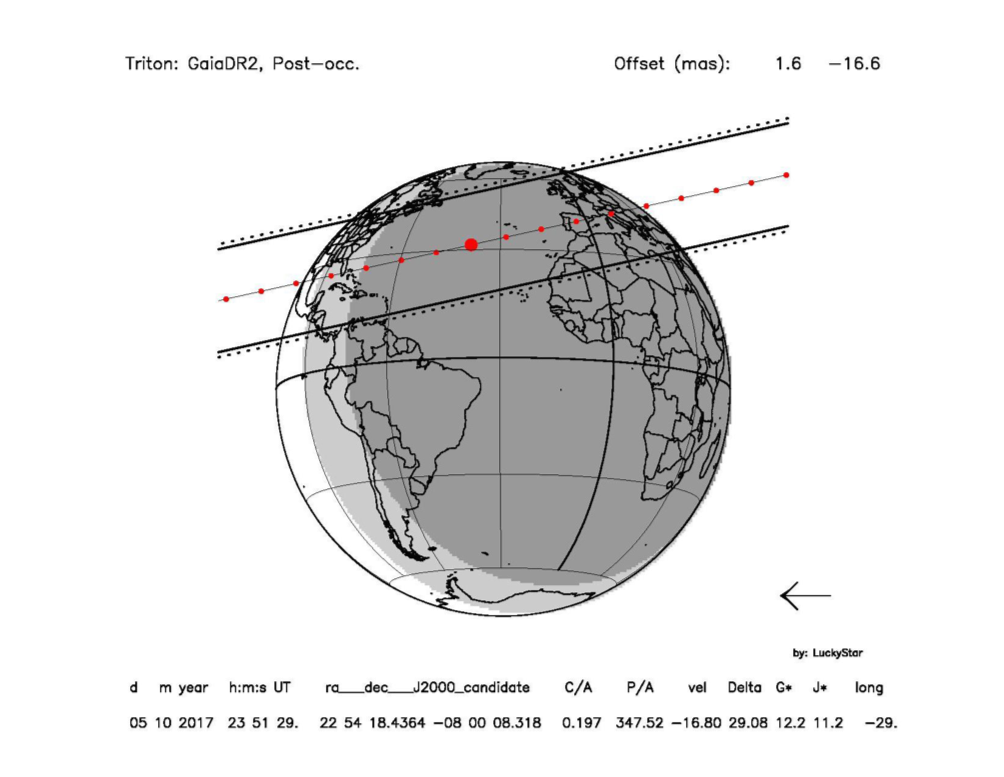IoW_20180227 - Gaia
Image of the Week |
Triton observation campaign |
|
|
|
Figure 1: Left - The reconstructed occultation geometry with the centrality line in red, compared to the latest prediction based on the preliminary DR2 star field prior to the event in pink. The two lines are separated by about 2 milli-arcsec when projected in the sky plane. The blue and pale-blue lines at the bottom are the respective limits (reconstructed and predicted) of the occultation shadow, below which no occultation was visible. The yellow pins mark the location of the stations that sent reports, with almost 80 of them actually recording the event. (Image credit: Google, INEGI, ORION-ME. Image annotation: ERC Lucky Star Project). Right - The central flash observed at Constancia (Portugal, courtesy Rui Gonçalves) and the C2PU 1.04m telescope of the Observatoire de la Côte d'Azur in south-east of France (Image copyright C2PU-OCA, 2017). |
|
The stellar occultation by Triton, the largest of Neptune's natural satellites, on 5 October 2017 was a rare occasion. Triton passed in front of a star of magnitude 12.6 allowing to observe the phenomenon called occultation. To help out the observation campaign of this rare and special phenomenon, Gaia released on 23 May 2017 the preliminary Gaia DR2 position of the star to be occulted by Triton. On 5 October Triton’s shadow first swept Europe and North Africa, and a few minutes later, the US East Coast (see Figures 1 and 2). On all three continents, a total of more than one hundred stations were ready to record the event, which had a maximum duration of three minutes. One of the main scientific goals of these observations was to derive Triton’s atmospheric structure from a few kilometres above the surface up to altitudes of about 150 km. Comparison with results obtained during the NASA Voyager 2 flyby in 1989 was of paramount importance, as Triton suffered an “extreme solstice” around 2000, when the Sun illuminated Triton’s southern polar cap. Seasonal effects may then have triggered a drastic surge of pressure that could still be going on – or not – until today. During the occultation, the stellar rays are refracted, and thus deviated by Triton's atmosphere. The latter thus acts as a lens that focuses the signal to the shadow center, creating a flash. This flash, called the central flash, can however only be detected in a small band bracketing the centrality. With a width of about 100 km, this band subtends about 5 milli-arcseconds (mas) when projected at Triton’s distance. Needless to say, planning the observation of the flash thus requires extremely accurate predictions that are now becoming possible thanks to the upcoming Gaia DR2 catalogue... |
|
Figure 2: Predicting the Triton occultation of 5 October 2017, using the preliminary star position of Gaia DR2 and the JPL DE435/NEP081 ephemeris for the Triton's position in the sky (image credit: ERC Lucky Star Project, Bruno Sicardy). |
|
At that level of accuracy, most of the uncertainty comes from the precision of Triton's position in the sky. Triton's ephemeris was computed using the JPL ephemeris DE435 for Neptune and NEP081 for Triton’s motion relative to Neptune. This ephemeris has not been not updated since 2009, and thus required updates for better predictions. Improving Triton's positionWith this in mind, a large campaign of observations was performed at the Observatório do Pico dos Dias (Brazil) by Marcelo Assafin and collaborators. Gathering data during eight nights from 15 to 23 September 2017, they obtained astrometric observations of Triton as it completed about one orbit around Neptune. These observations were reduced against the Gaia DR1 catalogue and used to determine an offset between the ephemeris and the observations. This offset was then used to refine Triton’s position at the time of the occultation. At his point (end of September), the Gaia team released the positions of 453 stars, providing their positions taken from the preliminary Gaia DR2 catalogue, and covering the path of Triton on the celestial sphere during September 2017 (see Gaia News of 30 September and 2 October 2017). Using this improved catalogue, M. Assafin and colleagues were able to further refine Triton’s offset, with estimated accuracies of 5.4 milli-arcsecond in right ascension and 2.6 milli-arcsecond in declination, respectively. Combined with the accuracy on the star position, this resulted in a final prediction with typical crosstrack uncertainty of 3 milli-arcsecond (corresponding to 60 km on Earth) and 8 seconds in time. This is an important result per se: even if the Gaia observations of the occulting body (here Triton) are not yet available in Gaia DR2, retrieving its accurate position at a few milli-arcsecond accuracy level is possible using classical CCD astrometry, backed up by the Gaia DR2 stellar catalogue. It is worth mentioning that Triton has been observed 22 times during the period planned to be included in Gaia DR3 and the anticipation is to achieve sub-milliarcsec position determination. This is good omen for future occultations, and an improvement of one order of magnitude compared to the pre-Gaia era. |
|
Figure 3: The same as Figure 2 but using the preliminary Gaia DR2 position of the occulted star, plus a Triton's offset derived for astrometric observations reduced against 453 preliminary DR2 star positions present in astrometric fields of view around Triton. This was the latest prediction made by the ERC Lucky Star Project, which was very close to what actually happened (see Figure 1 and Figure 4) (Image credit: ERC Lucky Star Project / Bruno Sicardy). |
|
While the Chariklo occultations of June and July made use of preliminary Gaia DR2 positions of the occulted stars only (see Gaia News of 23 May 2017 and story on the follow-up), this was the first occultation that used a preliminary Gaia DR2 star field to improve the astrometry of the object itself before the event. Also used of course was the preliminary Gaia DR2 position of the star that was released on 23 May 2017 as well. This eventually led to one of the most successful stellar occultations ever observed.
The most observed occultation everThe event was eventually attempted from more than one hundred sites in Europe, North Africa and eastern USA. Thanks to the accurate prediction and the good weather conditions generally prevailing over Europe, it was successfully monitored from more than 70 sites, 25 of them detecting the much wanted central flash. A reconstruction of the occultation geometry, using the best observations, shows that the latest prediction was accurate to within 8 seconds in time and 2 milli-arcsecond in distance, in agreement with the latest prediction described above, see Figures 2 and 3 for comparison, as well as Figure 4. Due to the large deployment of both professional and amateur stations, almost 80 positive records of the occultation (mostly in Europe) have been reported so far. Among them, about 25 detected an increase of light near the centre of the event. Some of them are marked in the left panel of Figure 1 and examples of central flashes are shown in the right panel. The shape of the flash is extremely sensitive to the global shape of the atmosphere that surrounds Triton at an altitude of about ten kilometers. Any large-scale distortions by a few kilometers would result in cusps in the central flash structure that are not observed, indicating an atmosphere close to spherical. However, some low-scale features observed in some flashes (see Figure 1) do suggest the presence of irregularities that will be quantified after comparing flashes observed at various distances to centrality. In the same vein, a comparison between the amplitudes of the flashes observed in various wavelengths will be important to assess the presence of hazes near Triton’s surface. Depending on the size of aerosol particles, the absorption of a stellar ray that traverses the atmosphere may depend on wavelength, thus informing us about the distribution size of those putative aerosols. This large success is comforting, as stellar occultations by Triton are rare (Neptune’s system is currently moving in low density stellar fields). The next opportunity is still far away into the future, occurring on 6 October 2022. It involves a G=11 star and will be visible from India, China and Japan, among others. |
|
Figure 4: Post occultation path of Triton's occultation using preliminary reduction of some of the observations, see Figure 3 for comparison with the latest update made before the event (Image credit: ERC Lucky Star Project / Bruno Sicardy). |
|
|
|
Credits: ESA/Gaia/DPAC, Bruno Sicardy, ERC Lucky Star Project, C2PU-OCA, Rui Gonçalves [Published: 27/02/2018] |
- Removed a total of (8) style text-align:center;
- Removed a total of (19) style text-align:justify;
- Removed a total of (1) style float:left;
- Removed a total of (1) style float:right;
- Removed a total of (1) border attribute.
- Removed a total of (1) cellpadding attribute.
- Removed a total of (1) cellspacing attribute.
Image of the Week Archive
- Removed a total of (1) border attribute.
- Removed a total of (1) cellpadding attribute.
- Removed a total of (1) cellspacing attribute.








































 Sign in
Sign in
 Science & Technology
Science & Technology




